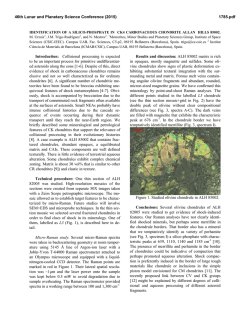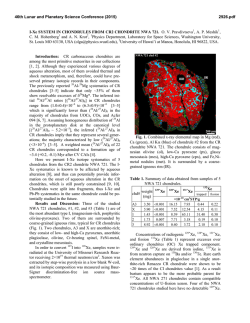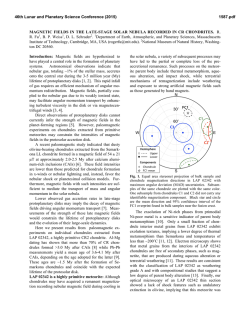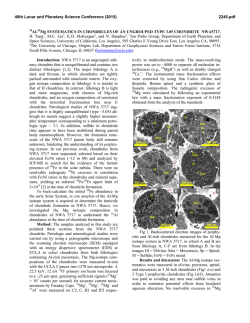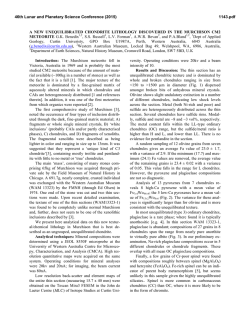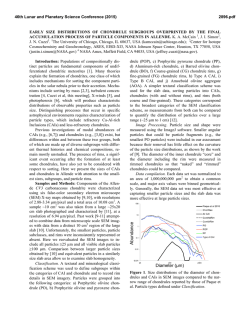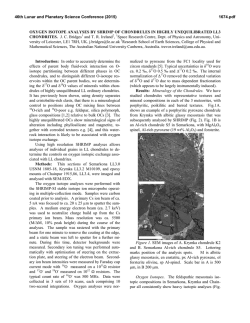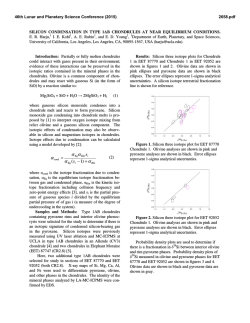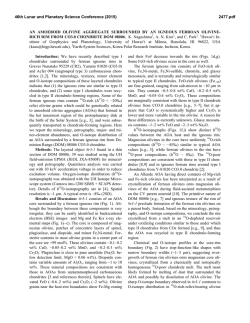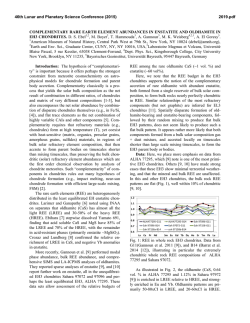
Chemical Composition of Cluster Chondrite Clasts in LL Chondrites
46th Lunar and Planetary Science Conference (2015) 2163.pdf CHEMICAL COMPOSITION OF CLUSTER CHONDRITE CLASTS IN LL CHONDRITES. K. Metzler1 and A. Pack2. 1Institut für Planetologie, Westfälische Wilhelms-Universität Münster, Wilhelm-KlemmStraße 10, 48149 Münster, Germany ([email protected]). 2Geowissenschaftliches Zentrum, GeorgAugust-Universität Göttingen, Goldschmidtstraße 1, 37073 Göttingen, Germany ([email protected]). Introduction: Many unequilibrated ordinary chondrites (UOC´s) contain lithic clasts of a unique chondritic lithology, termed cluster chondrite (clch) [1], which is characterized by close-fit textures of interlocking deformed and undeformed chondrules (Fig. 1). These clasts (up to 10 cm in size) are interpreted as fragments of coherent rocks of unknown original dimensions, incorporated into their host breccias prior to final lithification. Clch´s seemingly formed by the accretion of freshly formed hot and viscously deformable chondrules, together with undeformed ones, within hours to a few days after chondrule forming events. This time constraint is based on chondrule cooling rates, inferred from experimentally obtained crystallization textures of chondrule analog materials [2]. size and degree of deformation [1] was determined for all investigated chondrules, as well. Results: Bulk clch clasts. Basically, the bulk chemical composition of clch´s and other LL3 chondrites is very similar, with distinct depletions of FeO, K2O, Ni, and S in the former. This can be attributed to their lower amounts of Fe,Ni metal, troilite, and finegrained interchondrule matrix [1]. Furthermore, bulk clch´s have basically flat CI-normalized [3] REE patterns, similar to that of other LL3 chondrites. Chondrules. The mean chemical compositions of the chondrule populations in clch´s and other LL3 chondrites [4-6] are nearly identical. Other chemical similarities are: 1) concentrations of REE, Zr, and Hf are roughly correlated with that of Al and Ca [4]; 2) Basically flat REE patterns (Fig. 2) with numerous negative Eu anomalies [5], 3) Slight La<Lu (LREE<HREE) fractionations [6]. Fig. 2. Example (type II chondrules) of flat CI-normalized REE patterns with common negative Eu anomalies in clch chondrules. Fig. 1. Deformed chondrules in the clch clast from NWA 5421 The aim of this study is to chemically characterize clch´s and their components and to compare these results with literature data for other UOC´s. Samples and methods: The bulk chemical compositions (major and minor elements) of 7 clch clasts (petrologic types 3.2 to 3.8) from 6 different LL chondrites (Krymka, NWA´s 3119, 4522, 5205, 5421, 6742) were obtained by EPMA (fused beads). Bulk chondrule compositions were measured by SEM-EDX. The bulk concentrations of rare earth elements (REE), Zr, and Hf in the above clasts (except NWA´s 4522, 6742), their chondrules (n=93) and their interchondrule matrix portions (n=4) were measured in-situ by LA-ICP-MS at RSES (ANU, Canberra). The apparent Interchondrule matrix. The REE patterns for interchondrule matrix areas show slight to distinct positive Eu anomalies (Fig. 3). Those anomalies were also found in matrix material from other UOC´s and carbonaceous chondrites [7,8]. Fig. 3. REE patterns of interchondrule matrix portions 46th Lunar and Planetary Science Conference (2015) Chondrules with ultrarefractory REE patterns. Two chondrules exhibit REE patterns with distinct negative anomalies (Fig. 4) in Sm (arrows), Eu, and Yb. Those patterns have been previously described from 2 other UOC chondrules and are interpreted as the result of REE gas/solid fractionations in the solar nebula at supra-solar C/O ratios [9]. According to this scenario these chondrules acquired their patterns by incorporation of small amounts of highly reduced, ultrarefractory condensates in the precursor. Fig. 4. Ultrarefractory REE patterns in two PO I chondrules from clch clasts in NWA 5421 and NWA 5205. REE-enrichment in undeformed chondrules. A considerable fraction of undeformed chondrules is enriched in REE (Fig.5). The chondrule with the highest REE enrichment exhibits the ultrarefractory pattern shown in Fig. 4 (upper pattern). We used the MELTS program in order to check if their liquidus temperatures are extraordinarily high, which turned out not to be the case. Seven of these chondrules are of porhyritic type (3xPO, 3xPOP, 1xPP), indicating that an internal fabric of skeleton crystals like that in BO and RP chondrules cannot be the reason for a lowered tendency to deform [see 1], as well. Fig. 5. Concentration of Dy (representative of the entire REE inventory) vs. chondrule deformation. REE-enriched chondrules (filled circles) occur exclusively among the undeformed chondrules. 2163.pdf Discussion and conclusions: The main intention of this study was to clarify whether clch´s represent a peculiar type of otherwise normal UOC material or represent foreign inclusions of distinctly different matter. Based on the chemical and textural [1] similarities we conclude that clch chondrules represent typical UOC chondrules. At some time between formation of the viscously deformed chondrules and their trapping into solid rock (within hours to a few days) an older chondrule population was admixed. This is documented by the existence of undeformed chondrules [1], (some of which are enriched in REE; Fig. 5), which were possibly added to the hot chondrule population in a somewhat colder state. During the same period the accreting material obviously lost some of its metallic Fe,Ni and troilite, as indicated by distinct depletions of FeO, Ni, and S in bulk clch clasts. Perhaps the most important property of clch´s is their low amount of interchondrule matrix (3-9 vol%) [1]. Either this finegrained component was also extracted from the reservoir during the short period between chondrule formation and clch accretion or was never present in modal amounts typical for other UOC´s (10-15 vol%) [e.g. 10]. The lower concentrations of K2O in bulk clch´s compared to other LL3 chondrites point to the former scenario and shows that the lack of matrix is not related to incorporation of that material into the clch chondrules. This seems to be supported by the negative Eu anomalies in clch chondrules that is complementary to the positive Eu anomalies in matrix (Figs. 2, 3). Chondrules in clch´s were obviously frozen in a very early stage of accretion [1]. This offers the opportunity to investigate spatial relations between single chondrules that were established very early in UOC history. This is in strong contrast to other UOC´s, most of which are breccias, affected by repeated mixing of chondritic material of possibly different provenience [11]. References: [1] Metzler K. (2012) Meteoritics & Planet. Sci., 47, 2193-2217. [2] Hewins R. H. et al. (2005) In Chondrites and the Protoplanetary Disk. Astron. Soc. of the Pacific Conf. Series, 341, 286-316. [3] Lodders K. (2003) Astrophys. J., 591, 1220-1247. [4] Hutchison R. (2004) Meteorites - A petrologic, chemical and isotopic synthesis. Cambridge University Press, 506pp. [5] Pack A. et al. (2004a) LPS XXXV, Abstract #2062. [6] Gooding J. L. and Fukuoka T. (1982) Meteoritics, 17, 222-223. [7] Alexander C. M. O´D (1995) GCA, 59, 3247-3266. [8] Bendel V. et al. (2011) LPS XVII, Abstract # 1711. [9] Pack A. et al. (2004b) Science, 303, 997-1000. [10] Huss R. G. et al. (1981) GCA, 45, 33-51. [11] Scott E.R.D. (1984) Smiths. Contrib. Earth Sci. 26,73-93. This work was supported by the German Research Foundation (DFG; SPP 1385, ME 1115/8-1, -2).
© Copyright 2026
